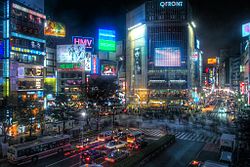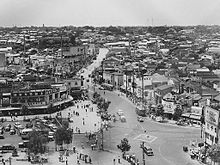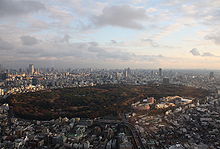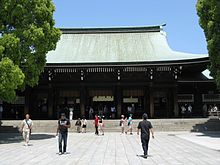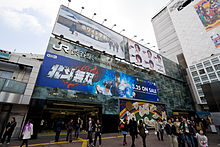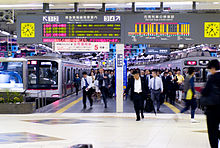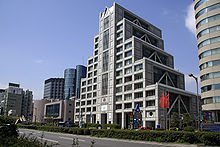- Shibuya, Tokyo
-
"Shibuya" redirects here. For other uses, see Shibuya (disambiguation).
Shibuya
渋谷— Special ward — 渋谷区 · Shibuya City Shibuya crossing at night 
FlagLocation of Shibuya in Tokyo Coordinates: 35°39′50.53″N 139°41′53.56″E / 35.6640361°N 139.6982111°ECoordinates: 35°39′50.53″N 139°41′53.56″E / 35.6640361°N 139.6982111°E Country Japan Region Kantō Prefecture Tokyo Government – Mayor Toshitake Kuwahara Area – Total 15.11 km2 (5.8 sq mi) Population (2008) – Total 208,371 – Density 13,540/km2 (35,068.4/sq mi) Time zone Japan Standard Time (UTC+9) Website www.city.shibuya.tokyo.jp Shibuya (渋谷区 Shibuya-ku) is one of the 23 special wards of Tokyo, Japan. As of 2008, it has an estimated population of 208,371 and a population density of 13,540 persons per km². The total area is 15.11 km².
The name "Shibuya" is also used to refer to the shopping district which surrounds Shibuya Station, one of Tokyo's busiest railway stations. This area is known as one of the fashion centers of Japan, particularly for young people, and as a major nightlife area.
Contents
History
Following the opening of the Yamanote Line in 1885, Shibuya began to emerge as a railway terminal for southwestern Tokyo and eventually as a major commercial and entertainment center. It was incorporated as a village in Minami-Toshima County (Toyotama County from 1896) in 1889, as a town in 1909, as a ward of Tokyo City in 1932, and as a ward of Tokyo Metropolis in 1943. The present-day special ward was established on March 15, 1947.
One of the most well-known stories concerning Shibuya is the story of Hachikō, a dog who waited on his late master at Shibuya Station every day from 1923 to 1935, eventually becoming a national celebrity for his loyalty. A statue of Hachikō was built adjacent to the station, and the surrounding Hachikō Square is now the most popular meeting point in the area.
Yoyogi Park in Shibuya was one of the main venues for the 1964 Summer Olympics. The ward itself served as part of the athletics 50 km walk and marathon course during those games.[1]
In 1965, 18-year-old Misao Katagiri, who had already shot and killed a policeman, went on a shooting rampage, and injured 16 more people. He was sentenced to death and was executed by hanging in 1972.
Shibuya has achieved great popularity among young people in the last 30 years. There are several famous fashion department stores in Shibuya. Shibuya 109 is a major shopping center near Shibuya Station, particularly famous as the origin of the kogal subculture. Called "Ichi-Maru-kyū," which translates as 1–0–9 in Japanese, the name is actually a pun on that of the corporation that owns it — Tokyu (which sounds like 10–9 in Japanese). The contemporary fashion scene in Shibuya extends northward from Shibuya Station to Harajuku, where youth culture reigns; Omotesandō, the zelkova tree- and fashion brand-lined street; and Sendagaya, Tokyo's apparel design district.
During the late 1990s, Shibuya also became known as the center of the IT industry in Japan. It was often called "Bit Valley" in English, a pun on both "Bitter Valley," the literal translation of "Shibuya", as well as Bit, the computer term for binary digits.
Geography
Shibuya includes many well-known commercial and residential districts such as Daikanyama, Ebisu, Harajuku, Hiroo, Higashi, Omotesandō, Sendagaya, and Yoyogi.
Districts
- Hatagaya
- Sasazuka, Hatagaya, Honmachi
- Yoyogi
- Uehara, Ōyamachō, Nishihara, Hatsudai, Motoyoyogichō, Tomigaya, Yoyogi-kamizonochō
- Sendagaya
- Sendagaya, Jingūmae
- Ebisu-Ōmukai
- Kamiyamachō, Jinnan, Udagawachō, Shōtō, Shinsenchō, Maruyamachō, Dōgenzaka, Nanpeidaichō, Sakuragaokachō, Hachiyamachō, Uguisudanichō, Sarugakuchō, Daikan'yamachō, Ebisunishi, Ebisuminami
- Hikawa-Shimbashi
- Shibuya, Higashi, Ebisu, Hiroo
Politics and government
Shibuya is run by a city assembly of 34 elected members. The current mayor is Toshitake Kuwahara, an independent backed by the Liberal Democratic Party and Komeito.
Elections
Sightseeing and historic sites
Green areas
- Meiji Shrine, Shinto shrine dedicated to the souls of Emperor Meiji and Empress Shōken, surrounded by a 700,000-square-meter forest.
- Shinjuku Gyoen (Sendagaya), former Imperial gardens now open to the public as a park.
- Yoyogi Park, once a training base for the Imperial Japanese Army, later the Washington Heights housing area for the Occupation of Japan, then the lodgings for contestants in the Tokyo Olympics.
Buildings
- Shibuya 109, a popular and trendy place for mostly Japanese young women to shop.
- United Nations University
- Bunkamura, theatre and concert hall complex
- Cerulean Tower, the tallest building in the Shibuya Station area
- Yebisu Garden Place (Ebisu), site of the former Sapporo Brewery, now featuring restaurants and shopping, along with the Westin Hotel
- National Noh Theatre (Sendagaya)
- New National Theatre (Hatsudai), site of opera, ballet, and other performances
- NHK Broadcasting Center, headquarters of the NHK radio, television, and satellite broadcasting system
- NTT Docomo Yoyogi Building, the third-tallest building in Tokyo, patterned after the Empire State Building
- Omotesandō Hills, a shopping mall completed in 2006
- Southern Terrace (Sendagaya)
- Takashimaya Times Square (Sendagaya), one of the largest department stores in Japan
- Tokyo Metropolitan Gymnasium (Sendagaya), a major indoor arena complex
- Tokyo Baptist Church
- Yoyogi National Gymnasium, designed for the 1964 Olympics by Kenzo Tange.
Streets and places
- Aoyama Dōri, a major east-west thoroughfare
- Center Gai
- Dōgen-zaka, a road in central Shibuya famous for its surrounding nightclubs and love hotels
- Komazawa Dōri – running past Daikanyama, down the hill to Ebisu, crossing Meiji Dōri and up the hill through Higashi, Tokyo and Hiroo. The road stops at the Shuto expressway in Minami Aoyama. Famed for its beautiful trees that turn bright yellow in autumn, cafes, restaurants and large replica of Michelangelo's David outside of the Papas building. Prince Hitachi and Princess Hitachi have their official residence in a palace in large gardens off Komazawadori in Higashi [2]
- Kōen Street, in central Shibuya between Shibuya Station and Yoyogi Park
- Meiji Dōri, a major north-south thoroughfare parallel to the Yamanote Line
- Miyamasu-zaka
- Omotesandō, an avenue leading up to the Meiji Shrine with a number of famous-brand boutiques
- Spain-zaka
- Takeshita Street, a shopping street through Harajuku
- Yamanote Street
- Shibuya
- Ebisu
- Harajuku
- Hiroo
- Sendagaya
- Yoyogi
crossing
Other
- Shibuya is famous for its scramble crossing. It is located in front of the Shibuya Station Hachikō exit and stops vehicles in all directions to allow pedestrians to inundate the entire intersection. Three large TV screens mounted on nearby buildings overlook the crossing. The Starbucks store overlooking the crossing is also one of the busiest in the world. The Shibuya Scramble is featured in the movie, Lost in Translation [3] and The Fast and the Furious: Tokyo Drift.
- On the northwest side of Shibuya station, there is a popular meeting place with a statue of Hachikō, while on the southwest side of Shibuya station there is another popular meeting place with a statue called "Moyai". The statue resembles a Moai statue, and it was given to Shibuya by the people of Niijima Island in 1980.
Transportation
Rail
The main station in Shibuya is Shibuya Station.
- JR East
- Yamanote Line: Yoyogi, Harajuku, Shibuya, Ebisu stations
- Chūō Line: Yoyogi, Sendagaya stations
- Saikyō Line, Shōnan-Shinjuku Line: Shinjuku (the part south of Kōshū Kaidō, including the New South Entrance, is in Shibuya), Shibuya, Ebisu
- Tokyo Metro
- Ginza Line: Shibuya Station
- Hibiya Line: Ebisu Station
- Chiyoda Line: Meiji Jingūmae, Yoyogi Kōen, Yoyogi Uehara stations
- Hanzōmon Line: Shibuya Station
- Fukutoshin Line: Shibuya, Meiji Jingūmae, Kitasandō stations
- Tokyo Metropolitan Bureau of Transportation Toei Ōedo Line: Shinjuku (in Yoyogi), Yoyogi, Kokuritsu Kyogi-jo stations
- Tokyu Corporation (Tōkyū)
- Tōyōko Line: Shibuya, Daikanyama stations
- Den-en-toshi Line: Shibuya, Ikejiri Ohashi stations
- Keiō
- Inokashira Line: Shibuya, Shinsen
- Keiō Line: Sasazuka Station
- Keiō New Line: Hatsudai, Hatagaya, Sasazuka stations
- Odakyū Odawara Line: Minami Shinjuku, Sangubashi, Yoyogi Hachiman, Yoyogi Uehara stations
- The Royal Platform (kyūtei hōmu), used by the Japanese Imperial Family on rare occasions, is located along the Yamanote Line, a few minutes walk from Harajuku Station in Sendagaya 3-chome.
Highway
- Shuto Expressway
- No.3 Shibuya Route (Tanimachi JCT – Yoga)
- No.4 Shinjuku Route (Miyakezaka JCT – Takaido)
- National highways
Economy
Several companies are headquartered in Shibuya.
Calpis,[4] Casio,[5] Niwango,[6] and Tokyu Corporation have their headquarters in Shibuya.[7] East Japan Railway Company,[8] Square Enix,[9][10] and Taito Corporation have their headquarters in Yoyogi, Shibuya.[11] 81 Produce has its headquarters in Tomigaya, Shibuya.[12][13]
Foreign operations
Campbells Soup's Japan division is headquartered in Shibuya.[14] The ABB Group's Japan headquarters are located in Shibuya.[15][16] Virgin Atlantic Airways's Japan office is on the sixth floor of the POLA Ebisu Building in Shibuya.[17] MTV Japan Ltd., which controls Nickelodeon Japan, has its headquarters in Shibuya.[18]
Former operations
At one time Smilesoft had its headquarters in Shibuya.[19] In May 1985 the headquarters of Bandai Visual moved to Shibuya. In March 1990 the headquarters moved to Shinjuku, Shinjuku, Tokyo.[20]
A.D. Vision - Tokyo, Y.K., the Japanese subsidiary of A.D. Vision, was in Shibuya.[21] Acclaim Entertainment once had its Tokyo office in the Nomora Building.[22]
Companies
- Amway Japan: Japan headquarters for Amway a multi-level marketing company
- Coca-Cola Japan
- Cyber Agent Ltd.: Internet advertising agency
- Dreamusic Incorporated: record label
- East Japan Railway Company (JR East) (Yoyogi)
- Gap Japan
- GlaxoSmithKline
- Ito En Ltd.: Bottler of tea, coffee, vegetable drinks and other beverages
- Kentucky Fried Chicken Japan Ltd.
- Microsoft Japan
- NHK (Nippon Hoso Kyokai) (NHK Broadcasting Center)
- Nippon Crown Records Co., Ltd.: a Japanese record label company
- PPG: Manufacturer of industrial coatings
- Papas: a clothing, cafe and bakery company, headquartered on Komazawadori in the neighbourhood of Higashi
- Sapporo Breweries Limited
- Square Enix: video game, manga producer
- Teichiku Records: record label
- Trend Micro Japan: security software company
- Jupiter: video game industry
Education
Colleges and universities
- United Nations University
- Aoyama Gakuin University
- Bunka Gakuen University (Yoyogi)
- Jissen Women's University
- Kokugakuin University (Higashi, Tokyo)
- University of the Sacred Heart (Hiroo)
- Tokai University
Primary and secondary schools
Shibuya operates public elementary and middle schools, while Tokyo Metropolitan Government Board of Education operates public high schools.
- Aoyama High School
- First Commercial High School
- Hiroo High School
Public libraries
Shibuya operates several public libraries, including the Central Library, the Nishihara Library, the Shibuya Library, the Tomigaya Library, the Sasazuka Library, the Honmachi Library, and the Rinsen Library. In addition, the Yoyogi Youth Hall houses the Yoyogi Library Room.[23]
See also
References
- ^ 1964 Summer Olympics official report. Volume 2. Part 1. p. 74.
- ^ Kunaicho |The Imperial Palace and other Imperial Household Establishments
- ^ Glionna, John M. (2011-05-23). "Japan's orderly Shibuya Scramble". Los Angeles Times. http://www.latimes.com/news/nationworld/world/la-fg-japan-intersection-20110523,0,4327748.story. Retrieved 2011-08-28.
- ^ "Company Outline." Calpis. Retrieved on February 12, 2010.
- ^ "Corporate." Casio. Retrieved on February 25, 2009
- ^ "会社情報." Niwango. Retrieved on February 26, 2011. "〒150-0001 東京都渋谷区神宮前1-15-2 ニコニコ本社ビル."
- ^ "会社概要." Tokyu Corporation. Retrieved on November 27, 2009.
- ^ East Japan Railway Company. "JR East Corporate Data". http://www.jreast.co.jp/e/data/index.html. Retrieved 20 June 2009.(English)
- ^ "Corporate Profile." Square Enix. Retrieved on January 30, 2011. "Headquarters Shinjuku Bunka Quint Bldg. 3-22-7 Yoyogi, Shibuya-ku,Tokyo 151-8544, Japan."
- ^ "Map." Square Enix. Retrieved on January 30, 2011. "Location Shinjuku Bunka Quint Bldg. 3-22-7 Yoyogi, Shibuya-ku, Tokyo 151-8544, Japan."
- ^ "Company Overview." Taito Corporation. Retrieved on January 30, 2011. "Head Office 15F, Shinjuku Bunka Quint Bldg,3-22-7 Yoyogi,Shibuya-ku,Tokyo 151-8648,JAPAN."
- ^ "株式会社81プロデュース 会社概要." 81 Produce. Retrieved on April 5, 2010.
- ^ "株式会社81プロデュース アクセスマップ." 81 Produce. Retrieved on April 5, 2010.
- ^ "Profile." Campbells Soup Japan. Retrieved on November 10, 2008.
- ^ "Addresses in Japan." ABB Group. Retrieved on February 6, 2009.
- ^ "Tokyo (26-1 Sakuragaoka-cho)." ABB Group. Retrieved on February 6, 2009.
- ^ "Japan Office." Virgin Atlantic Airways. Retrieved on 14 December 2009.
- ^ "会社情報." Nickelodeon Japan. Retrieved on August 31, 2010.
- ^ "会社概要." Smilesoft. February 12, 2002. Retrieved on February 11, 2010.
- ^ "History." Bandai Visual. Retrieved on March 16, 2010.
- ^ "Contact ADV." A.D. Vision. Retrieved on May 8, 2009.
- ^ "Worldwide locations." Acclaim Entertainment. June 23, 2000. Retrieved on July 8, 2010.
- ^ http://www.city.shibuya.tokyo.jp/eng/living/library.html
External links
- Shibuya official website in English
- Wikitravel Tokyo/Shibuya
- Shibuya Nightclub Guide in English
Tokyo Metropolis Special Wards 

Cities Districts and
SubprefecturesMetropolitan cities of Japan Tokyo Metropolis Designated cities Core cities Akita · Amagasaki · Aomori · Asahikawa · Fukuyama · Funabashi · Gifu · Hakodate · Higashiōsaka · Himeji · Iwaki · Kagoshima · Kanazawa · Kashiwa · Kawagoe · Kōchi · Kōriyama · Kumamoto · Kurashiki · Kurume · Maebashi · Matsuyama · Miyazaki · Morioka · Nagano · Nagasaki · Nara · Nishinomiya · Ōita · Okazaki · Ōtsu · Shimonoseki · Takamatsu · Takasaki · Takatsuki · Toyama · Toyohashi · Toyota · Utsunomiya · Wakayama · YokosukaSpecial cities Akashi · Atsugi · Chigasaki · Fuji · Fukui · Hachinohe · Hirakata · Hiratsuka · Ibaraki · Ichinomiya · Isesaki · Jōetsu · Kakogawa · Kasugai · Kasukabe · Kawaguchi · Kishiwada · Kōfu · Koshigaya · Kumagaya · Kure · Matsumoto · Mito · Nagaoka · Neyagawa · Numazu · Odawara · Ōta · Sasebo · Sōka · Suita · Takarazuka · Tokorozawa · Tottori · Toyonaka · Tsukuba · Yamagata · Yamato · Yao · YokkaichiPrefectural capitals
(not included above)Neighborhoods of Tokyo Akasaka · Akihabara · Aoyama · Asagaya · Asakusa · Asakusabashi · Azabu · Daikanyama · Den-en-chōfu · Ebisu · Futako Tamagawa · Ginza · Gotanda · Hamamatsuchō · Harajuku · Hibiya · Hongō · Ichigaya · Iidabashi · Ikebukuro · Iwamotochō · Jiyūgaoka · Jinbōchō · Jūjō · Kabukichō · Kagurazaka · Kajichō · Kamata · Kanda · Kasumigaseki · Kichijōji · Koishikawa · Kugayama · Kyōbashi · Kōenji · Kōjimachi · Marunouchi · Mita · Meguro-Mita · Nagatachō · Nihonbashi · Nishi-Shinjuku · Nishikichō · Ochanomizu · Odaiba · Ogawamachi · Ōizumigakuenchō · Ōmori · Omotesandō · Ōtemachi · Roppongi · Ryōgoku · San'ya · Sendagaya · Shiba · Shibaura · Shibuya · Shimokitazawa · Shinbashi · Shinjuku · Shinjuku ni-chōme · Shiodome · Shirokane · Shirokanedai · Sudachō · Sugamo · Surugadai · Takadanobaba · Takanawa · Tamachi · Tateishi · Tsukiji · Tsukishima · Uchi-Kanda · Uchisaiwaichō · Ueno · Wakasu · Yaesu · Yayoi · Yōga · Yotsuya · Yoyogi · Yūrakuchō
Venues of the 1964 Summer Olympics Asaka Nezu Park · Asaka Shooting Range · Chofu City · Enoshima · Fuchu City · Hachioji City · Hachioji Velodrome · Karasuyama-machi · Karuizawa · Kemigawa · Komazawa Gymnasium · Komazawa Hockey Field · Komazawa Olympic Park Stadium · Komazawa Volleyball Courts · Korakuen Ice Palace · Lake Sagami · Mitsuzawa Football Field · Osaka Nagai Stadium · National Gymnasium · Tokyo National Stadium · Nippon Budoka Hall · Nishikyogoku Athletic Stadium · Ōmiya Football Field · Prince Chichiba Memorial Football Field · Sasazuka-machi · Shibuya Public Hall · Shinjuku · Toda Rowing Course · Tokorozawa Shooting Range · Tokyo Metropolitan Gymnasium · Tokyo Metropolitan Indoor Swimming Pool · Waseda Memorial Hall · Yokohama Cultural GymnasiumCategories:- 1964 Summer Olympic venues
- Olympic athletics venues
- Wards of Tokyo
- Shibuya, Tokyo
- Entertainment districts
Wikimedia Foundation. 2010.

